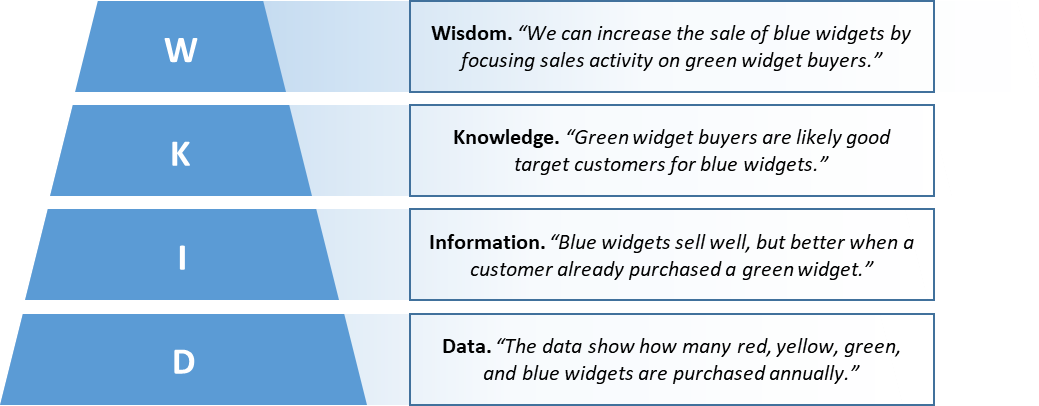Providing Real Value in Data Analysis
Data analysis has an image problem. Despite the fact that data collection is priority one, regardless of how common “big data” buzzwords have gotten, and setting aside all the calls for data-centric decision making… The boots on the ground, those of us who manage this analysis daily, have a problem.
Too many analysts are viewed as tactical cogs in a machine. We aren’t brought in to own and manage projects. We aren’t consulted on big ticket company objectives beyond the reports we’re asked to push out. Why? Because we aren’t doing enough to show value.
If we want to grow and improve, for the good of our own careers as well as for the benefit of the companies we work for, we need to figure out how to turn this around. So, how do we do it? By graduating from tactical resources to strategic powerhouses.
The DIKW Pyramid
The first step on the way to graduation is to reevaluate the DIKW pyramid. We’re all familiar with it, yet too many of us focus on the lower levels and never make it to the top. The top is, unquestionably, where we need to be.
As a brief refresher, here’s a quick example:

Too many of us focus on wrangling data, and “polish it up” by adding a little information-based context. Many of our reports don’t make it beyond the Information stage above. But widget-producing organizations don’t live or die based on how much they can talk about past widget sale activity. They survive by selling more widgets.
If data analysts want to elevate their position and perceived value, they need to align their deliverables to this business directive. Don’t focus solely on the D/I past; spend your time worrying about the K/W future. Beyond what our historic view shows, how can your company leverage it moving forward?
Presentation is Key
Now that we understand what we should be talking about, we need to address how we talk about it. Data analysts often earn the reputation of being all but indecipherable when talking to team members who aren’t steeped in facts and figures. Improving how we communicate will go a long way in graduating to strategic powerhouse.
- Develop a central idea.We know what we want to talk about – Blue widgets and increasing sales by targeting green widget customers. What about red and yellow widgets? What about the dozens of juicy KPIs (let alone hundreds of metrics) that describe all four flavors of widget? Forget them – they are for another day. Here and now, it’s all about increasing blue widget sales.
- Stick with that idea.As early as 1908, John Henry Jowett nailed effective public speaking after getting some sage advice from a fellow veteran preacher: “I take my text,” he said, “and divide my sermon into three parts. In the first part I tell ’em what I am going to tell ’em; in the second part—well, I tell ’em; in the third part I tell ’em what I’ve told ’em.” Anything you present up the ladder needs to be ruthlessly focused on supporting your central idea, but you also need to reiterate that idea and show how your content backs it up.
- Focus on your idea’s business-critical elements.Don’t make assumptions or gloss over details. State very clearly and specifically: Why should the audience care about your idea? What should the audience do? What can they expect from succeeding? If you can’t convey these answers clearly and concisely, your central idea will fall flat.
Prioritizing your Work
Our widget example is obviously oversimplified. In this case, there was a clear call to action and few variables to consider. Real life doesn’t work that way. As such, we need to consider how to spend our limited time. We need to prioritize projects that will give us the biggest bang for our buck.
- Prioritize big impact.We knew early on that blue widgets sold well. But how critical would our plan be if they didn’t? What if blue widget sales were only 5% of total sales, even with the green buyer boost? We would instead focus on higher selling items.
- Prioritize active projects.Some organizational initiatives attract big budgets, big teams for support, and have upper management’s eye. In other words, they’re in the spotlight. You want to be in the spotlight, too. That’s a match made in heaven – focus your resources there.
- Prioritize those who… prioritize data.Let’s face it: Some people don’t get data, won’t get data, and may even be hostile towards data. Don’t fight uphill battles that you don’t have to – prioritize teams with big impact, spotlight projects that dovalue data.
The Future of Analytics
To be incredibly blunt – there isn’t a future in straight data processing. Machine learning is getting too good. Your boss won’t need you to manage the tactical elements of data stewardship moving forward. In fact, they can likely already take raw data, plop it in a prepackaged BI platform, and have simple analyses generated for them in a matter of minutes.
What your boss needs from you (now, and increasingly in the future) is to step up and move beyond conducting the analysis to show what needs to be done as a result of that tactical work. Don’t just support change incrementally from behind your reports – be the catalyst for big ticket change.
When you subscribe to the blog, we will send you an e-mail when there are new updates on the site so you wouldn't miss them.
